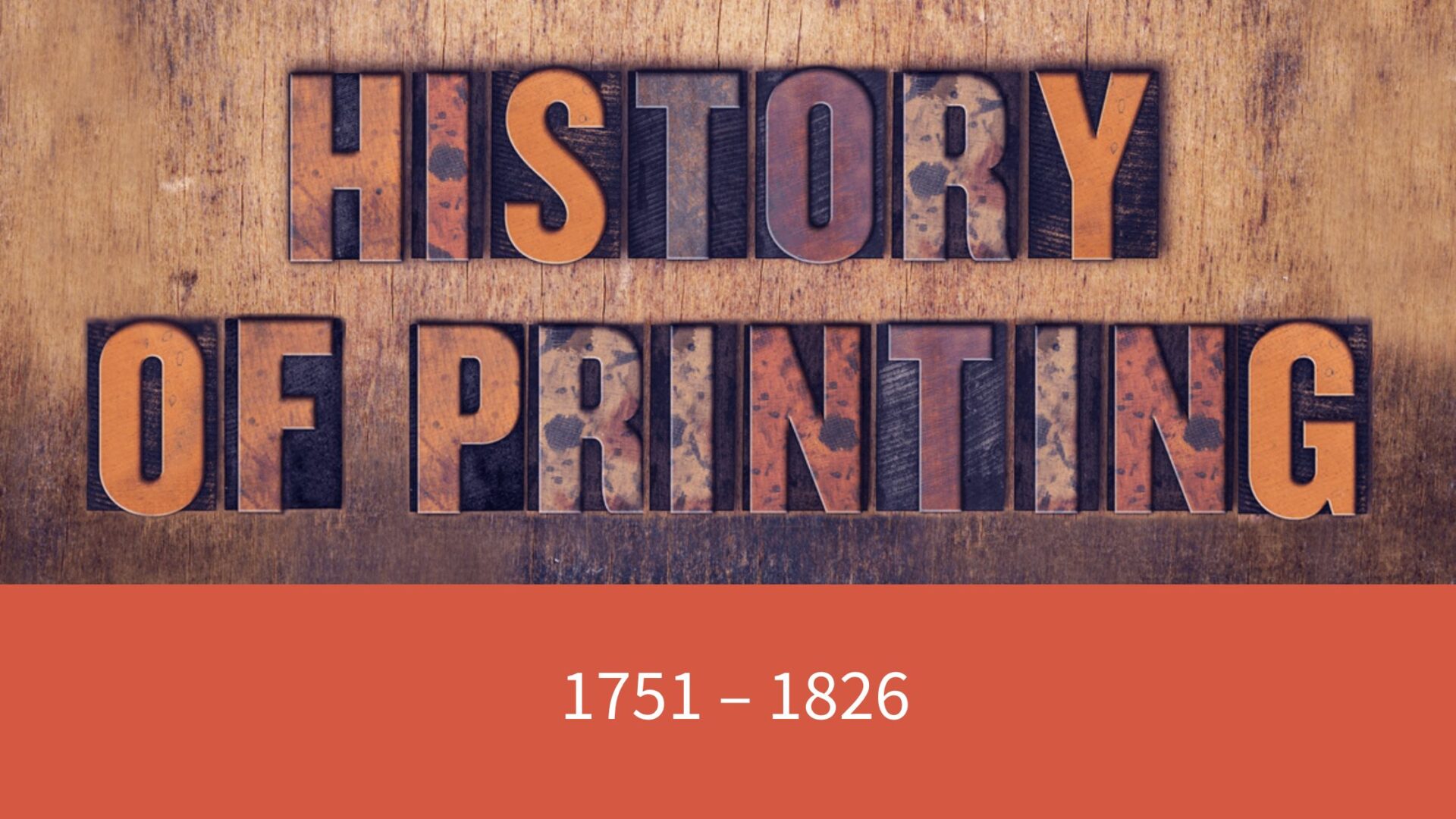History of Printing Timeline: 1751 – 1826
May 6, 2024 | Posted in: PGSF Blogs | Student Resources

Source – printinghistory.org/timeline/
1751
Diderot’s Encyclopédie published in France.
1752
Canada’s first newspaper the Halifax Gazette in Nova Scotia.
1755
A Dictionary of the English Language by Samuel Johnson.
The Printer’s Grammar by John Smith.
1757
Wove paper developed by James Whatman for Baskerville’s Virgil.
1764
Manuel Typographique by Pierre-Simon Fournier. A treatise on the history of French types and printing.
1768
Encyclopædia Britannica
1775
Common Sense by Thomas Paine.
Wood engraving developed by Thomas Bewick.
Kibyoshi, Japanese picture books, birth of the graphic novel.
1776
Declaration of Independence printed July 4 by John Dunlap.
1780
A typographic point system developed by (and later named for) François-Ambroise Didot. Based on the pre-metric French inch.
1786
Philadelphia printers conduct first successful strike for increased wages.
1790
William Nicholson (1753–1815) patents cylindrical printing press, London.
1793
The Marriage of Heaven and Hell by William Blake.
1796
Lithography invented by Alois Senefelder.
Binny & Ronaldson type foundry established in Philadelphia.
1798
Giambattista Bodoni designs a typeface in Parma (Italy).
1803
An all iron hand press built by Charles Mahon, third Earl of Stanhope.
Fourdrinier continuous web papermaking machine.
1803
Fourdrinier continuous web papermaking machine.
1805
R. Hoe & Company, a printing press manufacturer, established in New York.
Carbon paper developed.
1806
Canada’s first French language newspaper Le Canadien published in Quebec City until 1810.
1810
Composition ink rollers developed in London to replace ink balls.
The History of Printing in America by Isaiah Thomas.
1813
George Clymer develops the Columbian printing press, a cast-iron hand press featuring a lever, which replaced the simple screw mechanism for lowering the platen. It is distinguished by its bald eagle counterweight at top.
1814
Steam-powered, cylinder printing press, built by Frederick Koenig and Conrad Bauer installed at The Times in London.
1816
Sans-serif type shown in a specimen by William Caslon IV.
1818
Manual Tipografico by Giambattista Bodoni, posthumously published by his widow in Parma.
Stephenson Blake typefoundry established in Sheffield, England.
1820s
Photoengraving process emerges.
Albion press iron hand press developed by Richard Whittaker Cope. Its simple toggle action is an improvement on the complex lever-mechanism of the Columbian press and the Stanhope press.
American Daniel Treadwell developed the first bed and platen press powered by a treadle (London).
1821
Commercial lithographic firm established by William Armand Genet Barnet and Isaac Doolittle.
1823
Newly-founded Republic of Mexico establishes a Government Printing Office in Mexico City, inside the National Palace.
1824
Books bound in cloth issued by William Pickering in London.
1825
Typographia by Thomas Curson Hansard.
Louis John Pouchée, a London typefounder, produces ornamented types now regarded among the best of their kind.
1826
Daniel Fanshaw, NYC, arguably the first “production printer of the machine age.” Using Treadwell presses, he held the contracts for the American Bible Society and the American Tract Society. Active till about 1846.”
Paper first made in the Toronto area from rags in by Eastwood and Skinner.
Contributors
Substantive comments and suggestions provided by Abby Bainbridge, George Barnum, Barbara Beeton, Terry Belanger, Charles A. Bigelow, Frank Caserta, Douglas Charles, Sarah Chute, Walter Delaney, Erik Desmyter, Sue Durrell, Paul F. Gehl, Jeffrey D. Groves, John G. Henry, Howard Iron Works Museum, Amelia Hugill-Fontanel, Fritz Klinke, Joel Larson, Keelan Lightfoot, Mathieu Lommen, Se Eum Park, Stan Nelson, Xavier Querol, John Risseeuw, Helen Robinson, Paul Romaine, Frank J. Romano, Walker Rumble, Richard Saunders, Stephen O. Saxe, Ad Stijnman, Katherine Victoria Taylor, Philip Weimerskirch, Eric M. White, Colyn Wohlmut, Woo Sik Yoo, and Corinna Zeltsman.
Sources
Berry, W. Turner and H. Edmund Poole. Annuals of Printing, Blandford 1966
Chappell Warren. A Short History of the Printing Word, Hartley & Marks, 1999
Clair, Colin. A Chronology of Printing, Praeger, 1969
The GATF Encyclopedia of Graphic Communications. Graphic Arts Technical Foundation GATF Press, 1998
Moran, James. Printing Presses, University of California Press, 1973 | ebook
[Republic of Korea] Cultural Heritage Administration
Steinberg, S. H. Five Hundred Years of Printing, Oak Knoll & The British Library, 1996
Stijnman, Ad. Engraving and Etching 1400–2000. A History of the Development of Manual Intaglio Printmaking Processes. ‘t Goy-Houten-London, 2012
Wallis, Lawerence W. A Concise Chronology of Typesetting Developments 1886–1986 , Wynkyn de Worde Society/Lund Humpheries, 1992












